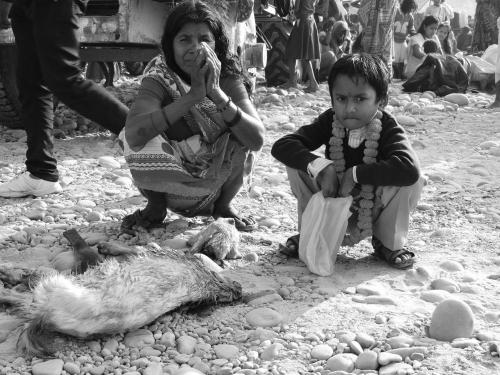
Reality[1]
On a recent Saturday morning I was sitting on the top step of the PKMM Hospital resource center gazing out across the road at a grassy area in front of a pond. At times, the stench from the grassy area and the pond is so overpowering it makes one gag. I've seen many people fishing in this pond; they most likely sell their catch at local markets. I've also seen buffaloes being washed in this very same pond.
I noticed a young man pull down his pants trying to defecate. He seemed to be having some trouble so he stood up, squatted, and stood up, squatted. Another young man came along and started urinating near the first boy. The second boy then brought out a bottle of water and helped the first boy to wipe his bottom.
Based on the 2011 Nepal Census, in Siraha District 79% of 118,000 households have no toilet; in Karjanha VDC where I am living this figure is 86% of 1403 households. Surrounding VDC's have very similar situations, e.g. Bhadaramal-71% of households have no toilet; Ramnagar Mirchaiya, the local city center 48%. The largest cities in Siraha have similar problems, i.e. Lahan Municipality at 40% and Siraha Municipality at 56% of households with no toilets.
I ask myself how can this be in the year 2071 (2014); maybe for the villages a dearth of toilets remains a problem, but what about urban areas? Isn't there enough infrastructure to support having at least one toilet in each household? Of course, people moving from rural to urban areas for job opportunities don't necessarily live in the best of housing circumstances.
I understand that this is the reality of where I'm living, that the literacy rate amongst households is low (Siraha 50%-62% males and 39% females, and in Karjanha 46%-59% males and 35% females), that people must use tube wells/hand pumps for their drinking water (is this water safe to drink?), 84% of households in Siraha, 97% in Karjanha; that in Siraha 37% use wood, collected daily, and 57% use cow dung for cooking while in Karjanha 82% use wood (precious women's time and energy spent on collecting firewood everyday instead of being able to work and adding to a household's income) and 14% use cow dung. In Siraha 2% of the Households have a computer, 36% a radio, 36% a TV and 56% own a mobile phone; in Karjanha 34% have a radio, 41% have TV, 10 Hhlds have a computer while 71% own a mobile phone.
As Administrator of a rural Hospital with infrastructure that is second to none, I wonder how to educate people about health issues (understanding about preventative measures instead of waiting for more serious conditions to occur before seeking medical advice) when the literacy rate and ownership of radios and TVs are all less than 50%? Part of the answer might lie in providing information through mobile phones, but even with the ownership rate above 50%, are those most impacted using phones? As an aside, a number of the maintenance staff at the Hospital are illiterate; they do possess a phone but can't read the numbers/letters, however someone at home reads for them. (This is also a function of not recognizing the English alphabet or numbers).
In some sense the Hospital provides a peek into a very different world for many people living in this area. At the Hospital there are people using computers and sophisticated equipment, there is power 24 hours/day, the furniture is fairly new, there are toilets and filtered, cold drinking water, some of the hostel rooms have a/c, refrigerators and gas cooking stoves, there is a clean restaurant and children's play equipment, etc.
I wonder what some of the citizens in this area think when they come to the Hospital not wearing any shoes/slippers, squatting on the floor instead of sitting in a chair, pulling their rupees out of a little pouch tucked into their tops, having traveled what I consider short distances, but spending a large amount of their time doing this? It's hard for me to say, having grown up in a totally alien environment, but there must be some culture shock. Or maybe not; maybe it's expected that this Hospital be very different from their daily internet free lives, that on some level this is "Oz".
I think that the daily reality of what I perceive as villager's struggles are very different from my own, in which I'm dealing with the complicated lives of not only myself but also of those of my colleagues.
On some level we all struggle with life, no matter who we are or what are our circumstances. The world has very different realities based upon our life experiences/circumstances, e.g. where we were fortunate enough to be born, who are parents are. The question for me then becomes how to bring very divergent realities together into a marriage that will create a better world for all? Certainly a difficult question but one that keeps me thinking about how might we, e.g. create enough understanding to enable 100% of households to have at least one toilet.
[1] Michael J. Rosenkrantz is the Primary Health Administrator/Community Outreach Specialists at Phul Kumari Mahato Memorial Hospital in Karjanha, Siraha where he has lived since June 1, 2014. Prior to this he spent 21 months as a VSO volunteer living in Kathmandu.










Add new comment